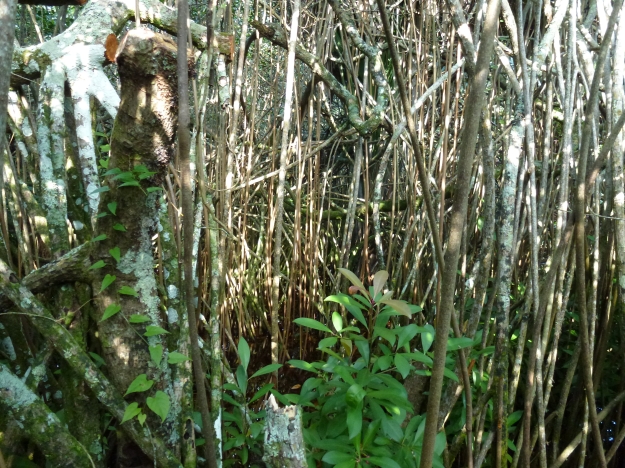The greening-up post hurricane has been astounding, we now have hibiscus flowers in the hedge again and it is actually green enough to be called a hedge.
What is less easy to see however is the damage along the Bermuda coast from the recent tropical storms. After the previous huge hurricane, Fabian, a lot of sediment was lost from the shores, seen on satellite images as a bright plume dragged out off the south-west into the Atlantic. But Bermuda is not all pink sand – in fact only 6% can be called beach, mostly along the South Shore. The rest is rocky shore, with a few cliffs and, hidden around a few corners, some mangrove swamps. I’m not talking acres of unnavigable jungle as you will recall from films (e.g. Black Water, a 2007 horror movie) , but square meters of important habitat along Bermuda’s coastline.
Mangroves are usually associated with tropical countries – they are halophytes, salt-tolerant species of tropical trees. Those on Bermuda are the most northerly mangrove forests in the Atlantic – so pretty unique. (My first draft had this as the northernmost in the world but then I learned that some in Japan reach 35 degrees North while Bermuda is at 32 degrees North! ) The largest area of mangrove swamp is at Hungry Bay, but that has been affected like the other 30 smaller areas on the island by rising sea level and human impact as well as hurricanes.
The bigger mangroves are Black Mangroves, Avicennia germinans, trees of up to 10m in height, with characteristic pneumatophores growing upwards out of the water. The Red Mangroves, Rhizophora mangle, called because of the red wood underneath the bark, have lots of prop roots growing downwards from the branches and trunk. Both are adapted to the salt water – red mangrove roots filter it out and then store what they don’t use in the leaves which then fall off, while the black mangrove excretes salt onto the leaves. The seeds on the red mangrove are clever, they have pendulum-like weights and after they have germinated, still on the mother plant, they are released and hopefully the weighted pod will plummet into the boggy ground and take hold. Black mangrove seeds need proper land to establish themselves in, they won’t grow in the water.
If you are in a kayak then the ones closest to the water will probably be red mangroves, the black ones being slightly inland in comparison, They are not exactly attractive so it is easy to see why they may have been ignored from the conservation aspect over the years. But they are an important habitat for herons, silk spiders, hermit crabs and juvenile fish. They also are a source of CRAP (yes, I did say that, it means Carbon Rich Aggregate Particles) which can be a food source for the reef creatures. Both red and black mangroves are listed under the Bermuda protected species act of 2011.
One can assume from place names that they were probably more plentiful in the past: Mangrove Bay on the west coast for example doesn’t actually advertise its name with a huge mangrove presence nowadays.
My photos are from Paget Marsh, which is slightly unusual in that the water there is fresh to brackish and not the usual salt water habitat where most Bermudian mangroves are found.
Loss of mangrove swamps on Bermuda could mean that the coast is not as well protected from future hurricanes and tidal activity. The density of their roots and trunks stabilise the sediment and mitigates wave damage, which protects the shore further inland. In other parts of the world mangroves are used in foods, furniture, even paper making or leather tanning. Bermuda has never had a commercial volume available, unlike the cedar wood that was used to within a tree or two of extinction, but just because it isn’t commercial doesn’t mean it isn’t valuable.




